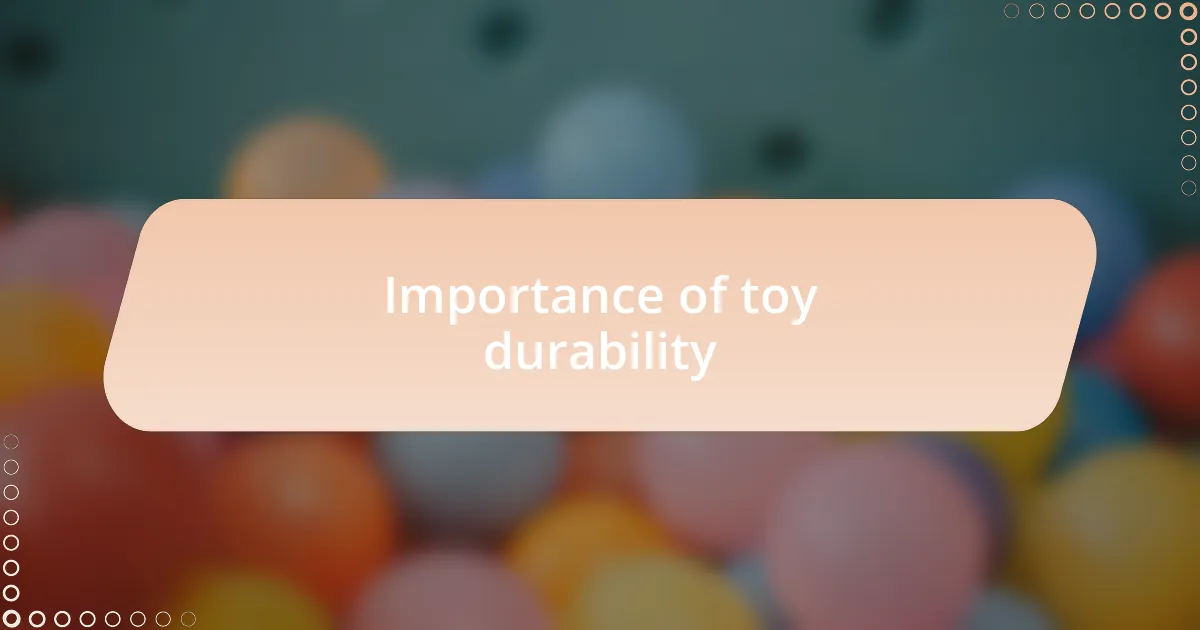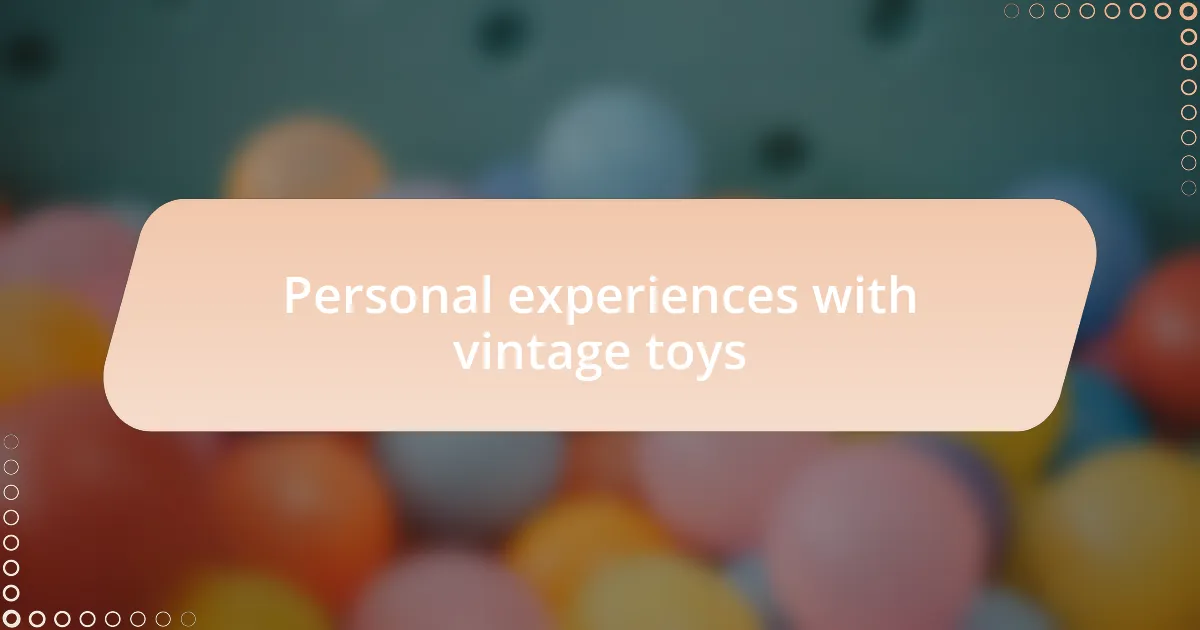Key takeaways:
- Vintage toys serve as emotional artifacts, reflecting the cultural and social values of their time and fostering nostalgia.
- Durability is crucial in toys, enhancing children’s imaginative play and allowing for generational connections and sustainability.
- Key factors contributing to toy durability include the quality of materials, design, and craftsmanship.
- Personal experiences with vintage toys deepen appreciation for their history and the memories they carry.

Understanding vintage toys
Vintage toys are not just relics of the past; they are windows into childhoods long gone. I remember opening a dusty box in my grandmother’s attic to find an old tin toy train. The feeling of nostalgia hit me instantly, and I realized these toys carry not just memories but a story behind their creation and use. Isn’t it fascinating how a simple object can evoke such powerful emotions?
When we talk about vintage toys, we must consider the era they represent. Each toy reflects the cultural and social values of its time, shaping the play experiences of children then and even now. Think about it—what does your favorite childhood toy say about your upbringing? In my case, the simplistic design of a wooden block set encourages creativity and imagination, showcasing how much value was placed on open-ended play before the proliferation of electronic gadgets.
Moreover, understanding vintage toys also means recognizing their craftsmanship. Unlike many modern toys, which prioritize mass production, vintage toys often emerged from a time when quality mattered. I once came across a meticulously crafted doll that had intricate hand-painted features, making it a true work of art. These details remind us that vintage toys are not just playthings; they are artifacts that reflect a different ethos about childhood and craftsmanship.

Importance of toy durability
When we talk about the importance of toy durability, it’s hard not to think about the joy of watching children play freely without worrying about breakage. I once observed my nephew engage in an epic adventure with a vintage pull-along toy. Watching him tug and pull it across the floor without a care in the world reminded me that a durable toy can truly enhance a child’s imaginative play. Durability ensures that those cherished moments aren’t cut short by a flimsy construction.
Moreover, durable toys serve as a bridge between generations, allowing parents and grandparents to share their fond memories with their children. I often think back to my first wooden train set. It endured countless sessions of imaginative storytelling and rough play, creating bonds that have lasted a lifetime. Isn’t it reassuring to know that a well-crafted toy can withstand the test of time and still inspire the same joy in the next generation?
Finally, considering the environmental impact adds another layer to the importance of toy durability. In a world where sustainability is becoming increasingly crucial, durable toys contribute to less waste and fewer resources consumed over time. Reflecting on this, I remember how my parents cherished their vintage toys, passing them down through our family. Isn’t it heartwarming to think that a single toy can create a legacy?

Key factors in toy durability
When assessing toy durability, materials make a significant impact. High-quality materials, such as solid wood or non-toxic plastics, often stand the test of time and the rigors of play. I remember the thrill of my childhood rocking horse, built from sturdy oak; its resilient construction meant it survived years of my enthusiastic galloping without any signs of wear. Isn’t it fascinating how the right choice of material can turn a toy into an enduring companion?
Another key factor is the design of the toy itself. Toys that are well-engineered tend to withstand rough-housing and the occasional tumble that comes with children’s play. For instance, I still cherish a vintage robot I had which, despite numerous falls off a shelf, always seemed to click back into shape. Doesn’t it evoke a sense of nostalgia to think of toys that could endure those spirited adventures, almost as if they have their own stories to tell?
Lastly, the craftsmanship behind the toy cannot be overlooked. Toys crafted with attention and care often exhibit superior durability. I recall discovering a vintage wooden puzzle made with precision; each piece snugly fit, enduring even the most boisterous puzzle-solving attempts by my cousins and me. How comforting it is to realize that investing in quality craftsmanship can lead to toys that become integral parts of our childhood memories.

Techniques for evaluating durability
When I evaluate toy durability, one technique I use is the stress test—essentially, I give the toy a little workout. For example, I once took an old action figure and subjected it to a series of playful tosses to see how well it held up. Each battle against gravity helped me gauge its resilience, revealing that some toys can endure much more than I initially expected. Have you ever thought about what it takes for a toy to survive the playful chaos of a child’s world?
Another method I’ve employed involves a visual inspection of the joints and seams. I like to closely examine where pieces connect, looking for signs of wear or weak spots. I remember coming across a vintage toy car with perfectly bonded wheels; it immediately struck me that such attention to detail not only signifies quality but also promises longevity. Don’t you find it eye-opening how even the smallest design element can signal whether a toy is built to last?
Lastly, I sometimes rely on the old standby of user reviews and feedback from fellow collectors. Hearing stories of how a toy fared in the hands of other children gives me valuable insights. I distinctly recall reading about a beloved stuffed animal that not only survived daily cuddles but also countless wash cycles, becoming even softer over time. It’s intriguing to think how shared experiences can create a fuller picture of a toy’s durability, right?

Personal experiences with vintage toys
As I reflect on my personal experiences with vintage toys, I can’t help but remember the joy of discovering my grandfather’s old tin robots. These toys were not just relics from a different era; they evoked feelings of nostalgia and wonder. Each winding of the key brought them to life, and I was always amazed at how well they survived the test of time, unlike many of my more modern toys that had quickly fallen apart.
One particular incident stands out vividly in my mind. I decided to take a risk and let a vintage wooden train set join a spontaneous afternoon of play. To my surprise, not only did it survive being zoomed across the living room floor, but it also sparked a wave of creativity as I designed elaborate tracks. The durability of that train set was inspiring—it not only endured the chaotic play but also enriched our family time.
I often ponder how my connection with these vintage toys goes beyond mere play; it’s a genuine bond that deepens my appreciation for their craftsmanship. Have you ever held a toy that seemed to carry the spirit of the childhood it once belonged to? I certainly have, and it always reminds me of the stories and memories woven into these treasured pieces. It’s these personal connections that elevate a vintage toy from just an item to a meaningful part of our lives.

Tips for determining lasting quality
When assessing a vintage toy’s lasting quality, I always start by examining the materials used. Toys crafted from solid wood or durable metal tend to stand the test of time better than those made from flimsy plastic. Recently, I found an old pull-along duck made of thick wood that still had its paint intact, and it sparked not just curiosity but a deeper appreciation for the craftsmanship involved.
Next, I focus on the construction techniques. A well-assembled toy, like those featuring sturdy joints or quality stitching, often indicates a longer lifespan. I recall a vintage stuffed bear that I’d inherited; its stitching held tightly even after countless cuddles and adventures. Have you noticed how some toys seem to tell a story just by how well they’ve held up?
Finally, I consider the toy’s design. Retro designs that encourage imaginative play not only inspire creativity but also prove to be more robust in the face of rough use. I remember a figurine from a classic train set that survived drop after drop. It was a simple design, yet it endured, reminding me that quality over quantity prevails when it comes to childhood treasures.

Conclusion on vintage toy durability
When it comes to vintage toy durability, it becomes clear that not all toys are created the same. I’ve seen some remarkable pieces endure 30 or more years of play, while others sadly fall apart within just a few uses. Isn’t it fascinating how a simple design, when crafted with care, can withstand the trials of time and the enthusiasm of children?
Durability also reflects the intent behind the toy’s creation. I once stumbled upon a classic toy train that had clearly been loved and fiercely played with yet showed only minor signs of wear. The maker’s attention to detail was evident—every screw and nail held firm—and it made me wonder, did they create it with the hope that it would be cherished for decades?
Ultimately, these vintage toys are more than just playthings; they embody a story and history, connecting us to our past. The enduring quality of a well-made toy can evoke nostalgia and even bring a smile to our faces as we recall our childhood adventures. Have you experienced that incredible moment when you discover a timeless treasure that reminds you of your youth?